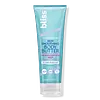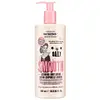What's inside
What's inside
 Key Ingredients
Key Ingredients

No key ingredients
 Benefits
Benefits

 Concerns
Concerns

 Ingredients Side-by-side
Ingredients Side-by-side

Water
Skin ConditioningLactic Acid
BufferingCaprylic/Capric Triglyceride
MaskingButyrospermum Parkii Butter
Skin ConditioningGlycerin
HumectantDimethicone
EmollientGlycolic Acid
BufferingPEG-100 Stearate
Glyceryl Stearate
EmollientSodium Hydroxide
BufferingOctyldodecanol
EmollientCetearyl Alcohol
EmollientAmmonium Acryloyldimethyltaurate/Vp Copolymer
Glyceryl Stearate Se
EmulsifyingC13-15 Alkane
SolventCocos Nucifera Oil
MaskingMandelic Acid
AntimicrobialXanthan Gum
EmulsifyingSqualane
EmollientTetrasodium Glutamate Diacetate
Phenoxyethanol
PreservativeEthylhexylglycerin
Skin ConditioningChlorphenesin
AntimicrobialWater, Lactic Acid, Caprylic/Capric Triglyceride, Butyrospermum Parkii Butter, Glycerin, Dimethicone, Glycolic Acid, PEG-100 Stearate, Glyceryl Stearate, Sodium Hydroxide, Octyldodecanol, Cetearyl Alcohol, Ammonium Acryloyldimethyltaurate/Vp Copolymer, Glyceryl Stearate Se, C13-15 Alkane, Cocos Nucifera Oil, Mandelic Acid, Xanthan Gum, Squalane, Tetrasodium Glutamate Diacetate, Phenoxyethanol, Ethylhexylglycerin, Chlorphenesin
Water
Skin ConditioningParaffinum Liquidum
EmollientGlycerin
HumectantIsostearyl Isostearate
EmollientDimethicone
EmollientSteareth-21
CleansingCetearyl Alcohol
EmollientButylene Glycol
HumectantPetrolatum
EmollientSteareth-2
EmulsifyingPrunus Amygdalus Dulcis Oil
Skin ConditioningSodium Polyacrylate
AbsorbentPhenoxyethanol
PreservativeParfum
MaskingButyrospermum Parkii Butter
Skin ConditioningPolysorbate 20
EmulsifyingTheobroma Cacao Seed Butter
EmollientCaprylyl Glycol
EmollientDipropylene Glycol
HumectantLactic Acid
BufferingMangifera Indica Fruit Extract
Skin ConditioningEthylhexylglycerin
Skin ConditioningSodium Benzoate
MaskingRosa Canina Fruit Oil
EmollientXanthan Gum
EmulsifyingLimonene
PerfumingAlpha-Isomethyl Ionone
PerfumingButylphenyl Methylpropional
PerfumingLinalool
PerfumingTetrasodium EDTA
Coumarin
PerfumingCitronellol
PerfumingCitrus Nobilis Peel Oil
MaskingBenzyl Alcohol
PerfumingDehydroacetic Acid
PreservativeCI 19140
Cosmetic ColorantCI 15985
Cosmetic ColorantWater, Paraffinum Liquidum, Glycerin, Isostearyl Isostearate, Dimethicone, Steareth-21, Cetearyl Alcohol, Butylene Glycol, Petrolatum, Steareth-2, Prunus Amygdalus Dulcis Oil, Sodium Polyacrylate, Phenoxyethanol, Parfum, Butyrospermum Parkii Butter, Polysorbate 20, Theobroma Cacao Seed Butter, Caprylyl Glycol, Dipropylene Glycol, Lactic Acid, Mangifera Indica Fruit Extract, Ethylhexylglycerin, Sodium Benzoate, Rosa Canina Fruit Oil, Xanthan Gum, Limonene, Alpha-Isomethyl Ionone, Butylphenyl Methylpropional, Linalool, Tetrasodium EDTA, Coumarin, Citronellol, Citrus Nobilis Peel Oil, Benzyl Alcohol, Dehydroacetic Acid, CI 19140, CI 15985
 Reviews
Reviews

Ingredients Explained
These ingredients are found in both products.
Ingredients higher up in an ingredient list are typically present in a larger amount.
This ingredient is also known as shea butter. It is an effective skin hydrator and emollient.
Emollients help soothe and soften your skin. It does this by creating a protective film on your skin. This barrier helps trap moisture and keeps your skin hydrated. Emollients may be effective at treating dry or itchy skin.
Shea butter is rich in antioxidants. Antioxidants help fight free-radicals, or molecules that may harm the body. It is also full of fatty acids including stearic acid and linoleic acid. These acids help replenish the skin and keep skin moisturized.
While Shea Butter has an SPF rating of about 3-4, it is not a sunscreen replacement.
Shea butter may not be fungal acne safe. We recommend speaking with a professional if you have any concerns.
Learn more about Butyrospermum Parkii ButterCetearyl alcohol is a mixture of two fatty alcohols: cetyl alcohol and stearyl alcohol. It is mainly used as an emulsifier. Emulsifiers help prevent the separation of oils and products. Due to its composition, it can also be used to thicken a product or help create foam.
Cetearyl alcohol is an emollient. Emollients help soothe and hydrate the skin by trapping moisture.
Studies show Cetearyl alcohol is non-toxic and non-irritating. The FDA allows products labeled "alcohol-free" to have fatty alcohols.
This ingredient is usually derived from plant oils such as palm, vegetable, or coconut oils. There is debate on whether this ingredient will cause acne.
Due to the fatty acid base, this ingredient may not be Malassezia folliculitis safe.
Learn more about Cetearyl AlcoholDimethicone is a type of synthetic silicone created from natural materials such as quartz.
What it does:
Dimethicone comes in different viscosities:
Depending on the viscosity, dimethicone has different properties.
Ingredients lists don't always show which type is used, so we recommend reaching out to the brand if you have questions about the viscosity.
This ingredient is unlikely to cause irritation because it does not get absorbed into skin. However, people with silicone allergies should be careful about using this ingredient.
Note: Dimethicone may contribute to pilling. This is because it is not oil or water soluble, so pilling may occur when layered with products. When mixed with heavy oils in a formula, the outcome is also quite greasy.
Learn more about DimethiconeEthylhexylglycerin (we can't pronounce this either) is commonly used as a preservative and skin softener. It is derived from glyceryl.
You might see Ethylhexylglycerin often paired with other preservatives such as phenoxyethanol. Ethylhexylglycerin has been found to increase the effectiveness of these other preservatives.
Glycerin is already naturally found in your skin. It helps moisturize and protect your skin.
A study from 2016 found glycerin to be more effective as a humectant than AHAs and hyaluronic acid.
As a humectant, it helps the skin stay hydrated by pulling moisture to your skin. The low molecular weight of glycerin allows it to pull moisture into the deeper layers of your skin.
Hydrated skin improves your skin barrier; Your skin barrier helps protect against irritants and bacteria.
Glycerin has also been found to have antimicrobial and antiviral properties. Due to these properties, glycerin is often used in wound and burn treatments.
In cosmetics, glycerin is usually derived from plants such as soybean or palm. However, it can also be sourced from animals, such as tallow or animal fat.
This ingredient is organic, colorless, odorless, and non-toxic.
Glycerin is the name for this ingredient in American English. British English uses Glycerol/Glycerine.
Learn more about GlycerinLactic Acid is another well-loved alpha hydroxy acid (AHA). It is gentler than glycolic acid but still highly effective.
Its main role is to exfoliate the surface of the skin by loosening the “glue” that holds dead skin cells together. Shedding those old cells leads to smoother, softer, and more even-toned skin.
Because lactic acid molecules are larger than glycolic acid, they don’t penetrate as deeply. This means they’re less likely to sting or irritate, making it a great choice for beginners or those with sensitive skin.
Like glycolic acid, it can:
Lactic acid also acts as a humectant (like hyaluronic acid). It can draw water into the skin to improve hydration and also plays a role in the skin's natural moisturizing factor (NMF) in the form of sodium lactate.
Studies show it can boost ceramide production to strengthen the skin barrier and even help balance the skin’s microbiome.
To get results, choose products with a pH between 3-4.
Lower strengths (5-12%) focus on surface exfoliation; higher strengths (12% and up) can reach deeper in the dermis (deeper, supportive layer) to improve skin texture and firmness over time.
Though it was originally derived from milk, most modern lactic acid used in skincare is vegan. It is made through non-dairy fermentation to create a bio-identical and stable form suitable for all formulations.
When lactic acid shows up near the end of an ingredient list, it usually means the brand added just a tiny amount to adjust the product’s pH.
Legend has it that Cleopatra used to bathe in sour milk to help reduce wrinkles.
Lactic acid is truly a gentle multitasker: it exfoliates, hydrates, strengthens, and brightens. It's a great ingredient for giving your skin a smooth, glowing, and healthy look without the harshness of stronger acids.
Read more about some other popular AHA's here:
Learn more about Lactic AcidPhenoxyethanol is a preservative that has germicide, antimicrobial, and aromatic properties. Studies show that phenoxyethanol can prevent microbial growth. By itself, it has a scent that is similar to that of a rose.
It's often used in formulations along with Caprylyl Glycol to preserve the shelf life of products.
Water. It's the most common cosmetic ingredient of all. You'll usually see it at the top of ingredient lists, meaning that it makes up the largest part of the product.
So why is it so popular? Water most often acts as a solvent - this means that it helps dissolve other ingredients into the formulation.
You'll also recognize water as that liquid we all need to stay alive. If you see this, drink a glass of water. Stay hydrated!
Learn more about WaterXanthan gum is used as a stabilizer and thickener within cosmetic products. It helps give products a sticky, thick feeling - preventing them from being too runny.
On the technical side of things, xanthan gum is a polysaccharide - a combination consisting of multiple sugar molecules bonded together.
Xanthan gum is a pretty common and great ingredient. It is a natural, non-toxic, non-irritating ingredient that is also commonly used in food products.
Learn more about Xanthan Gum